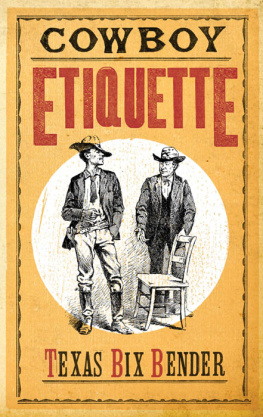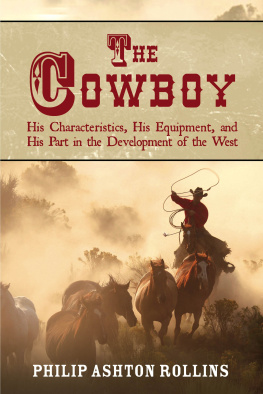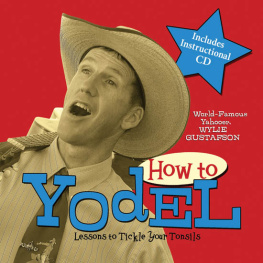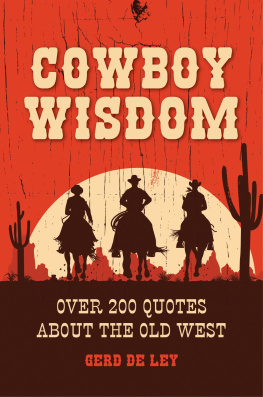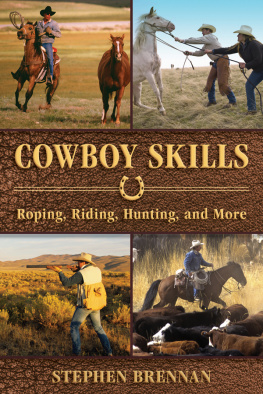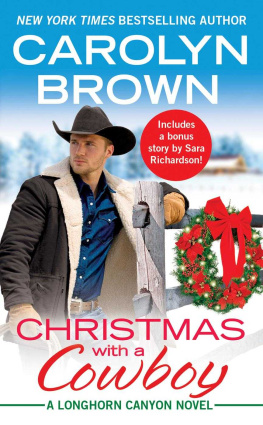Bibliographical Note
This Dover edition, first published in 2003, is an unabridged republication of the work originally published by Hastings House, New York, in 1958.
Library of Congress Cataloging-in-Publication Data
Ward, Fay E.
The cowboy at work / Fay E. Ward.
p. cm.
Originally published: New York: Hastings House, 1958.
Includes index.
9780486146232
1. CowboysWest (U.S.) 2. Ranch lifeWest (U.S.) 3. West (U.S.)Social life and customs. I. Title.
F596.W33 2003
636.2130978dc21
2003043778
Manufactured in the United States of America
Dover Publications, Inc., 31 East 2nd Street, Mineola, N.Y. 11501
To my friend, Bill Simpson, and all other old-time cowhands who rode the open range in those days. May they never be forgotten.
FOREWORD
In presenting this book for public consideration, my purpose is to make available to all those who happen to be interested the facts pertaining to the history of the cowhand, the type of equipment he used in his everyday work, and how he used it. I have tried to present a clear and useful outline of the methods an experienced cowhand employed in his work on the open range.
I must confess that in the beginning this book was designed to be a complete cowboys manualnot, indeed, purporting to tell the experienced cowhand how to go about getting his job done, but as an authoritative reference work for all those interested in the cowhand as he functioned in his job during the period when there was still plenty of open range for him to circulate in. The illustrations are examples of my first efforts at serious drawing, for which I make due apology; but it is hoped that they will be a useful supplement to the text for which they were drawn originally, more than twenty years ago.
The author worked as a horse wrangler, cowhand, bronc breaker and rough-string rider for cow outfits in Canada, and for outfits extending from there to the border of Mexico, for a period of over forty years. He feels somewhat qualified, therefore, to speak with authority about the methods and equipment employed by cowhands in their work.
Nuff said, amigos!
EVOLUTION OF THE COWBOY
The evolution of the American cowboy and his equipment dates back to the Spanish conquest of Mexico in 1519 by Cortes and his conquistadors. The descendants of these same adventurous conquistadors settled in Mexico. Some of them became owners of large estates and were known as hacendados, and their extensive ranches were called haciendas. Eventually they drifted northward with their great herds of longhorn cattle and mustang horses and crossed the Rio Bravo, now called the Rio Grande.
The stock industry thrived and spread from Texas to California, and there naturally came into being a great number of stockmen who operated on a smaller scale than the hacendados. They were known as rancheros, or small ranch owners. The men who were employed to handle the range stock were known as vaqueros, meaning cowboys. The term buckaroo in common use in the West is derived from this Spanish word.
When Texas gained her independence in 1836, the American cowboy came into being. The Mexican ranchers abandoned their ranches and drifted muy pronto across the Rio Grande to avoid the wrath of the Tehanos. Even before the departure of the Mexican ranchers, and as early as the first Spanish settlements in Texas, a great many horses and a large number of cattle escaped and went wild in the brush. Since the Spaniards did not castrate their animals, these escaped horses and cattle multiplied rapidly, so that, together with the animals the Mexicans abandoned when they trekked back across the Border, the wild herds became incredibly numerous. The great number of horses and cattle running wild tempted many a buffalo hunter and Indian scout to go into the cattle business, for cattle and horses were to be had for the taking.
Naturally the Americans adopted the equipment and methods used by the Mexican rancheros and vaqueros . Therefore, the style of equipment used by the early-day buffalo hunters and scouts had its influence, to a certain extent, upon the outfits used by the old-time cowhand that followed. The illustrations on Plates 2 and 3 show the various stages of development of the cowhands equipment.
During the Civil War many of the ranchers and cowhands deserted the ranches and enlisted in the service of the Confederate army. As a consequence, the cattle and horses that were left to range unmolested increased to even greater numbers and ran wild over a vast territory. When the war was over, many of the former cowmen returned to their old occupation and with them came ex-soldiers, their friends and friends of their friends who saw that here was a great opportunity to build up independent stock businesses. When the northern trails were opened, the Texas cowhand came into his own. It is estimated that fully ninety per cent of the old-time Texas cowhands were former Confederate soldiers.
During the period from 1865 to 1895, the cowhand and his equipment changed materially. In California the Spanish methods and equipment retained their influence upon the outfits of the cowhand much longer than in any other part of the cow country north of the Mexican Border.
When the northern trails were closed, the northern cowhand became an important factor in the cattle businesses, and the equipment and methods he used were the result of Texas and California influences. But these influences, when fused with and then modified by conditions of climate and locale, produced a distinct type, as easily distinguishable and recognizable as its Texas or California counterparts.
However, Texas, California and Montana cowhands are the same kind of guys under the skin; they differ, actually, only in the style of their equipment and in the methods used in their work which are largely shaped by the kind of country they operate in and the sort of weather they have to face.
The species cowhand is no special breed of human; but he is a special type created by his special way of life. Perhaps, though, it does take a special kind of guy to choose to be a cowhand. The cowhand is possessed by a sort of pioneering spirit; he likes naturethat is, nature in the raw. He doesnt mind taking a chance, win or lose. He can take it on the chin and keep coming back for more.
The cowhand and the stock range are as closely identified with each other as the cowhand and his horse. Anything written about the evolution of the cowboy assumes that the reader has some knowledge of the history of the cow country and the stock business. The author realizes that the short outline presented above does not cover the subject adequately. However, he hopes it will help in the understanding of the pages that follow which have, moreover, been made as self-explanatory as possible.





